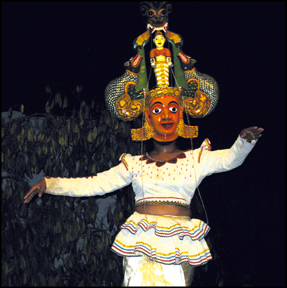Review
Kolam of Ambalangoda and Ariyapala clan
Harbingers of the tradition
By Ranga CHANDRARATHNE
Over six generations, the clan of Ariyapala in the Southern coastal
township of Ambalangoda have been preserving and passing on the
tradition of Kolam which is unique to the area, to the posterity.
Following the demise of Ariyadasa Gurunnanse who was famous for
preserving the tradition of carving out masks, the present members of
the clan including his eldest son Bandu Wijesooriya single-handedly
carries on the tradition braving the tempest of socio-economic changes
brought about by modernity. In recognition of unique contribution by the
clan, Germany has gifted a museum of masks and institute for preserving
Kolam. Young members of the clan like Rukmal Wijesooriya and Amaka
Wijesooriya, representing the seventh generation, stand out for their
dedication and commitment to preserving this inimitable tradition of
Kolam which , for them, is a way of life.
 |
|
Kolam performer |
The performers with wooden masks had descended on the stage in
specially constructed hut known as Kolam Maduwa. They danced before an
eager audience.
For it was a rare occasion when the Kolam Maduwa was recently held in
Ambalangoda. The spectators were virtually taken by surprise as the
performers of Kolam enacted different scenes wearing Kolam masks.
Men and women behind the performance and the Kolam Maduwa were none
other than the members of the Ariyapala clan and students of the
Kalayathanaya (Institute of Kolam dance).
Though origin of Kolam is, by now, untraceable, this unique form of
mask dance has settled down along the Southern coastal line during the
British occupation of Sri Lanka. At first Kolam assumes a ritualistic
form which is enacted about one and half day in a specifically
constructed hut known as Kolam Maduwa. A significant aspect of Kolam is
that each and every performer wears a mask and the story often depicts
the socio-economic set up of the colonial era. According to the
tradition, Kolam dance is performed in a Kolam Maduwa specially
constructed with special foliage. Diverse acts of Kolam are performed
over a period of one and half days.
The legend says that Kolam dance originated with an irresistible
craving of a powerful queen to watch a mask dancing when she was
pregnant. The queen's desire was so intense that she eventually became
sick. So the king pleaded with god Sakkra to solve this predicament. God
Sakkra hearing the plea, had dropped masks and text in the garden. So,
accordingly the first ever Kolam dance was performed. Traditional Kolam
Maduwa concludes with Gara Yaka's arrival dispeling all the evil
influences on the spectators. Among the famous Kolam, Nonchi Kolama,
Raja Thunkatuwa, Badadaru Kolam, Parangi Kolam and Kapiri Kolama are
prominent.
Mask Museum
Perhaps, the most significant contribution by Ariyapala clan to the
preservation of the Kolam is the Museum of Masks and library which will
preserve the rich tradition handed down from generation to generation.
The Museum depicts the richness of the mask tradition of Ambalangoda
and cultural heritage of Kolam masks. The museum, the workshop and the
small library (containing all available anthropological literature on
masks performances) serve as a centre for traditional arts and crafts
and for research on Kolam and Masks.
The Kalayathanaya (Institute for Kolam dance) is run by Kanchana
Wijesooriya and Maheshika Wijesooriya, daughters of late Ariyapala
Gurunnase who was famous for carving out exquisite Kolam Masks. Which
play a major role in Kolam performance Masks are made out of soft wood
from the Kaduru tree which grows near paddy fields. After carving out
the mask, it is treated and dried up so that the Kolam mask will last
for over 150 years. Mahinda Wijesooriya's son Rukmal Wijesooriya and
Hadananda Wijesooriya's son Amalka Wijesooriya who are engaged in the
Kolam Mduwa represent the seventh generation of the clan. Lack of state
patronage and the cost incurred in conducting Kolam Maduwa and
performances are some of the constraints they face against preserving
this unique tradition.
|

